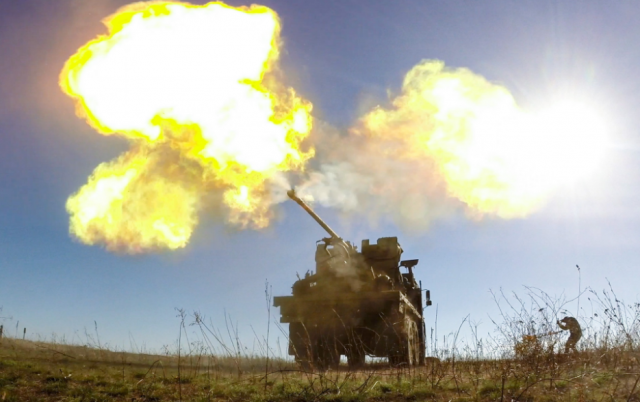The Ministry of Defense of the Russian Federation has repeatedly shown footage of the combat operation of the S-60 automatic anti-aircraft gun mounted on a mobile platform in the zone of special military operation (SVO). The gun, whose history began during the Great Patriotic War, successfully hits various targets on the modern battlefield. About how the S-60 continues to serve the country, as well as about the 57 mm caliber — in the TASS material
The S-60 anti-aircraft artillery system is used during a special military operation using the tactics of the "nomadic gun". The 57 mm automatic cannon is mounted on a tracked or wheeled chassis (for example, on an MT-LB tracked tractor or in the back of an army truck). Due to this, the calculation can quickly take up a firing position, and after firing at another target, it can be quickly replaced.
"The goals we are working on are the forest plantations where the enemy is sitting. We are being informed of the coordinates. We leave at these coordinates and work out," the Russian Defense Ministry quoted the commander of the gun with the call sign Govar as saying.
The honored veteran of anti—aircraft artillery also strikes enemy aircraft during its operation - however, in a different way than is inherent in its design. For example, in one of the episodes of combat work, the calculation of the S-60 anti-aircraft gun (ZU) destroyed the building where the UAV operators and a stock of drones (the so-called "poultry house") were located.
The high characteristics of anti-aircraft artillery systems allow them to effectively hit ground targets. This feature is standard in all modern anti-aircraft self-propelled guns. They are assigned to the air defense of the Ground Forces (SV), designed to cover units on the march and the battlefield, therefore they are able to repel attacks by a ground enemy — manpower, armored vehicles.
The history of creation and the combat path
The 57 mm automatic cannon began to be developed at the end of the Great Patriotic War at the Central Artillery Design Bureau (CAKB) under the guidance of the famous designer of artillery systems Vasily Grabin. As the fighting showed, anti-aircraft gunners needed automatic installations of a larger caliber, capable of reaching aircraft at increased flight altitudes during the war, as well as fighting with the armor that some machines had acquired. In addition, the speeds of combat aircraft have increased — jet aircraft have appeared.
At the end of 1946, the prototype of the gun passed field tests, but subsequent improvements took three years. In early 1950, a promising gun was adopted under the name "57 mm automatic anti-aircraft gun AZP-57". A cannon with a barrel longer than 4 m could destroy air targets at an altitude of up to 5 km. The rate of fire reached 120 rounds per minute. The combat rate of fire was significantly lower, as the AZP-57 fired shells in clips of four ammunition. In addition, with intensive firing, the barrel of the gun overheated — without cooling after every 15 shots, it was recommended to let the anti-aircraft gun cool down for five minutes. The gun was mounted on a towed four-wheeled platform, its mass in combat position was almost 5 tons.
The main difference between the new product and previous anti-aircraft artillery installations was the high automation of combat work. Thanks to this, the AZP-57 battery turned into one of the first anti-aircraft complexes. The gun was aimed at the target remotely thanks to tracking drives under the control of anti-aircraft artillery fire control devices (PUZO), and they received target designation from various radar facilities. In total, the battery with centralized control could include up to eight guns.
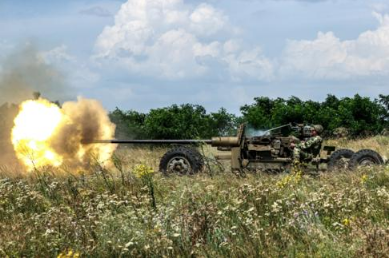 |
| The S-60 anti-aircraft artillery complex. |
| Source: Alexander Polegenko/ TASS |
The debut of the AZP-57, or S-60 complex, took place during the Korean War. Despite the revealed design flaws, which were then eliminated, the gun successfully shot down American aircraft. In Soviet times, S-60 anti-aircraft guns were widely exported, participated in combat operations in Vietnam, and numerous local conflicts.
From "Hell's Thresher" to "Spider"
The disadvantage of towed S-60 anti-aircraft guns is low mobility, so already in 1947, under the leadership of Grabin, the Central Research Institute-58 began to create a self-propelled anti-aircraft artillery system on a modified chassis of the T-54 medium tank. It used two barrels and automatic loading from the AZP-57. Electrohydraulic drives were aimed at the target of the anti-aircraft tank gun, the total ammunition was 300 shells. The cannon was located in a spacious tower, open from above. The self-propelled gun received the C-68 index, and in 1955 it was adopted under the name ZSU-57-2. For its firepower, the installation was nicknamed the "Infernal Thresher". However, other characteristics of the S-68 — the absence of an on—board radar, the low reaction time to the target - no longer allowed them to effectively combat modern jet aircraft.
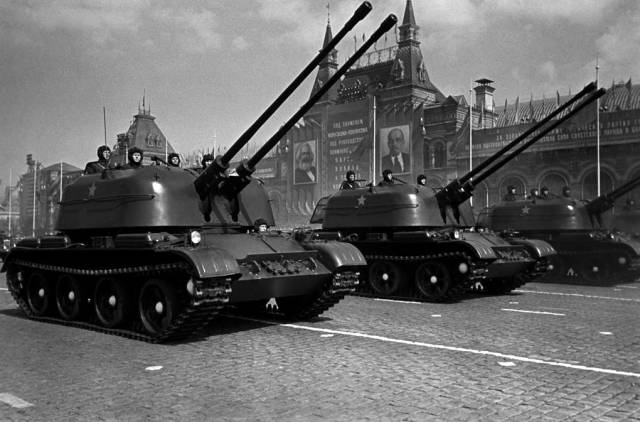 |
| Self-propelled anti-aircraft gun ZSU-57-2, 1959. |
| Source: © TASS |
In 1958, the twin ZSU-57-2 artillery installation received a naval registration: the AK-725 double-barreled turret naval artillery installation was adopted. It used tape ammunition from a large-capacity under-deck bunker, and the barrels had a continuous water cooling device, which significantly increased the number of shots without overheating. The AK-725 is still used in ships of the Russian Navy, sailors regularly carry out firing drills from it.
The success of the solutions incorporated into the S-60 complex by the designers can be judged by the foreign artillery installation presented several years ago. During the international arms exhibition IDEX 2019, the defense conglomerate Golden Group from the UAE and the Slovenian company Valhalla jointly showed the remotely controlled Spider combat module ("Spider"). The five-ton turret with bulletproof armor can be mounted on carriers or installed permanently to protect objects. Its main caliber is a 57 mm automatic belt-powered cannon — according to the Army Recognition portal, it is based on an upgraded Soviet long-lived anti-aircraft gun.
Renaissance caliber 57 mm
Interest in 57-mm guns has re-emerged in the recent period of the history of military equipment. Domestic gunsmiths have released several remotely controlled combat modules with 57 mm automatic guns at once. Thus, the specialists of the Central Research Institute "Burevestnik" have designed the AU-220M combat module, designed for installation on various armored vehicles. There is also a ship-based version of the weapon.
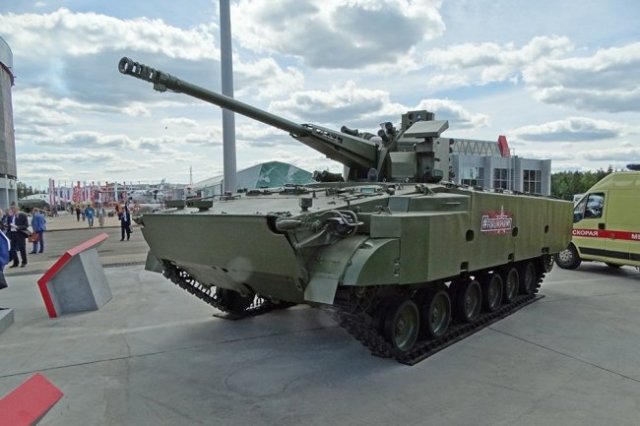 |
| The 2S38 Derivation-Air Defense combat vehicle, equipped with a rapid-firing 57 mm cannon, is a sensation of the exhibition. |
| Source: Alexey Moiseev |
In 2018, the 2S38 anti-aircraft artillery complex "Derivation-Air defense" was presented at the Army forum. It was created on the chassis of the BMP-3 infantry fighting vehicle with the AU-220M module and is designed to combat modern means of air attack — cruise and aviation missiles, small drones — in the near zone. To do this, the "Derivation-Air defense" is capable of firing 57-mm projectiles with programmable air detonation. Several such projectiles can destroy a swarm of drones with a cloud of damaging elements. The tests have already confirmed the effectiveness of the new self-propelled anti-aircraft gun. In addition, the promising self-propelled gun is capable of fighting various ground targets.
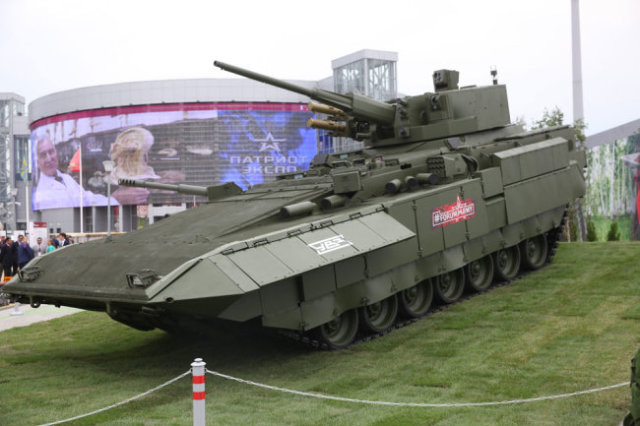 |
| Equipping the T-15 Armata BMP with a new module will significantly increase combat power. |
| Source: Sergey Mikheev/ RG |
Another application of the AU-220M is as part of the T—15 heavy infantry fighting vehicle on the Armata platform. In this version, the AU-220M cannon is complemented by supersonic anti-tank missiles "Ataka". Initially, a module with a 30 mm automatic cannon was installed on the T-15.
"Last year we completed the development of several new systems at once," Bekhan Ozdoev, industrial director of the cluster of armaments, ammunition and special chemicals of Rostec State Corporation, told TASS in an interview in April this year. — Among them are the 152-mm wheeled howitzer "Malva", the self-propelled 82-mm mortar "Drok", the 57-mm anti-aircraft artillery complex "Derivation-air defense". This technique has advanced combat qualities and provides good protection for the crew. It is very necessary in the area of its own, we understand this and have done everything to complete the task as quickly as possible."
Victor Bodrov
The materials of Alexander Shirokorad's book "The Genius of Soviet Artillery. The triumph and tragedy of V. Grabin"
